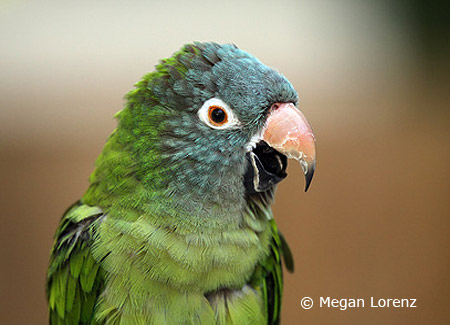Blue-crown Conures
Common Names:
Blue-crowned Conure, Blue-crown Conure, Blue-hooded Conure, & Blue-capped
Conure
Scientific Name:
Aratinga acuticaudata
Origin: South
America (Argentina, Bolivia, Brazil, Columbia, Paraguay, Uruguay, and
Venezuela)
Relative Size: 14-15
inches
Weight: 160-170
grams
Average Lifespan:
20-30 years
Egg Clutch: 3-4
white eggs
Incubation: 24 days
Talking Ability:
Moderate

General Information about Blue-crown Conures
Blue-crown Conures thrive in tropical habitats. In the wild these birds live in large flocks and feed from fruit trees. They enjoy grouping with other conures and other parrots throughout the day. Like most parrots, they are very noisy in flight. A group of 30 or more Blue-crown Conures can easily be spotted in the trees as their loud calls quickly reveal their location. When they are quiet it can be difficult to spot them due to their coloring.
More recently these conures have been thrust into the spotlight through
the popular documentary known as The Parrots
of Telegraph Hill. The film features many conures, and
among them, Blue-crown Conures are shown. This was not the only silver
screen appearance of this particular parrot. Another fictional movie
called Paulie also cast a Blue-crown
Conure as the main character.
Description
The Blue-crown Conure is not as brightly colored as other conures. Instead, it has only a few colors softy blended together to make the conure look distinct. The conure has a light blue hood that covers the crown, forehead, and the cheeks. Around the eyes a white ring is present. The body is solid green; however, different hues of green are visible. When the tail is fanned open red can be seen. The underside of the wings and tail are also yellow and red. The beak is multicolored; the upper mandible is beige and the lower mandible is black. On average these conures are around 14- 15 inches in length.
Blue-crown Conures As Pets
Blue-crown Conures make wonderful pets. They are not as prone to biting as most parrots. If fact, these parrots can be trusted to interact with family members without being too aggressive. Their docile, yet playful personalities make them attractive candidates for first time parrot owners. Another positive trait is their knack for talking. Unlike most conures who cannot talk, Blue-crown Conures can pick up human speech. Though their talking ability is not as clear as Indian Ringnecks or Quaker Parakeets, they still are somewhat understandable. Their voices are often reported as sounding muffled and high. They are fantastic pets, and if well socialized and tamed, they will gladly bring hours of joy into thier owner's life.
Blue-crown Conures are known for being noisy. These conures will
easily give off a piercing call to get their owner’s attention. Careful
techniques should be used from the beginning to help minimize their
excessive calling. If the conure should break into a screaming
fit, the owner should never yell at the
bird, give the bird direct eye contact, or spray the bird with water.
Instead, this behavior should be ignored completely. Approaching the
conure’s cage to scold him may only reinforce screaming and it could
make it worse.
These are very social and smart creatures that will quickly mold their
behavior to their owner’s liking. The owner can do this by ignoring
unwanted behavior and praising preferred behavior. Please note that a
Blue-crown conure cannot be training to completely be silent. They will
naturally make noise during the morning, noon, and before sunset. If an
owner is seeking a quieter conure for apartment living then it is highly
suggested a Green Cheek Conure be looking into.
Blue-crown Conures should be allowed plenty of exercise.
Keeping these birds confined to cage all day is not advised. They enjoy
climbing and chewing, and as a result, proper hand toys and ropes should
be included into the bird’s cage. A play stand should also be provided
to allow exercise outside the cage.
If the owner plans to be away for more than a few hours, it is advised
to turn on a radio or television to help entertain the conure while out.
This will help minimize boredom in a pet conure.
Tricks
Blue-crown Conures are great at performing tricks. They are not shy and will gladly work for praise or treats. These birds can be taught to pick up coins and place them into a piggybanks, lie on their backs, ring a bell, or retrieve objects. It is important to understand tricks are only limited to their owner's imagination. If the owner wishes to promote tricks then positive reinforcement training will be needed.
A Blue-Crown Conure Diet
Because these parrots come from South America, they need to be
provided with fresh fruits and vegetables daily. Tropical fruit is
perfect for conures, especially small chunks of papaya, mango, and figs.
These conures should not be fed avocados or chocolate. These are toxic
substances that will usually result in death if given. Alcohol beverages
should never be given to parrots as well. Blue-crown Conures are not
picky. Very rarely will these conures turn down a fresh bowl of fruits
and vegetables.
It's important to feed a pet conure a stable diet of seeds and pellets.
Feeding a pet conure just seeds or just pellets can be harmful. They key
is to balance everything in their diet and offer everything in
moderation. Conures have the potential to live 20-30 years. If the owner
meets this diet demand and takes thier conure to the vet regularly, they
can prolong their parrot’s life and expect him to reach 20 or more
years.




